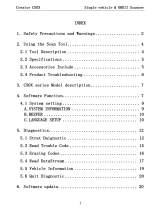
Pins 2, 6, 7, 10, 14, 15
Blue/Red dual color LEDs
Blue color: Normal protocol
communication (pulse) signal.
Red color: Constant voltage present.
Depending on the communication
protocols (Pin 6: CAN H, Pin 14: CAN L),
Pin 2: Bus + Line), (Pin 10: PWM-), (Pin 7:
ISO-9141
K-Line & Pin 15: L-Line) the Blue LEDs will
blink accordingly when signal voltage is
detected. If the unit detects constant 12V
on these pins, the LED will stay on and
become RED.
Default Pin display is always set to pin 16
with corresponding battery voltage display
on its voltmeter (example: 12. V) detected
from the DLC.
Pins 3,8,9,11,12,13
Blue/Red dual color LEDs
Blue color: Normal protocol
communication (pulse) signal.
Red color: Constant voltage present.
Pins 1
Yellow/Red dual color LEDs
Yellow color: Normal communication
(pulse) signal.
Red color: Constant voltage present.
If pulse voltage is detected on pin 1, its
LED will turn Yellow.
If pulse voltage is detected on any of
these pins 3,8,9,11,12 and 13, its respective
LEDs will turn Blue.
Please note
manufacturers use many of these pins
for special purposes (example: pin 8 is
used by Nissan for ignition voltage) other
than the communication protocol signals.
If the breakout box detects constant 12V
present on these pins, the LED will stay on
and become RED.
Note: Due to the fluctuations of voltage
readings in Pulse voltage, the unit will only
display peak to peak voltage of the pulse.
Pin 4 & Pin 5
Green/Red dual color LEDs
Green color: Correct grounding (-).
Red color: Reversed polarity (+) detected.
When the OBD-II Break Out Box is
plugged into the vehicle DLC and detects
reverse polarity in pin 4 and 5, the LED will
turn RED.
This indicates incorrect polarity.
DLC Connector Light:
Pressing the power will illuminate a
flashlight in the DLC connector to aid in
locating the vehicles DLC.
To replace the flashlight battery, remove
the battery cover on the rear of the DLC
connector. (Replace with CR1220)
Product Warranty
The OBD-II Break Out Box comes with a
one (1) year warranty and undergoes strict
quality control for testing workmanship,
function, and safety before leaving the
factory. From the date of purchase, we will
warranty/repair the OBD-II Break Out Box
against defects in parts and workmanship.
All repairs due to misuse or tampering
with will incur a charge. All warranty units
must be accompanied by a copy of the
original sales receipt.
This warranty does not apply to products
which have been:
• Altered
• Improperly installed
• Damage by accident, negligence, or
misuse
THE WARRANTY WILL B VOIDED FOR
ALL INCIDENTAL OR CONSEQUENTIAL
DAMAGES AS A RESULT OF MISUSE.
Warranty Claims:
Please include a copy of the original
receipt and return to:
Power Probe Group, Inc.
2810 Coliseum Centre Drive,
Ste. 100.Charlotte, North Carolina
28217 USA
Out of Warranty Repairs:
Please contact our Tech Support
department regarding non-warranty
repairs or service.
Ph: (833)533-5899
Email: cs.na@mgl-intl.com
Operations:
This OBD-II Break Out Box is applicable for 12V and 24V systems. Once plugged into the vehicle DLC (OBD port)
it will start to check the pins for any voltage present. If voltage is present, the respective LEDs will illuminate as follows:


